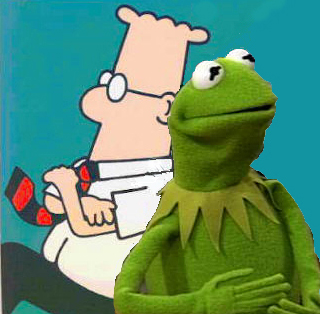|
|
|
|
|
|
|
|
|
Dilbert vs Kermit the Frog |
|
|
|
I thought
"it's not easy being green” is Kermit's line.
Originally published in the Sept/Oct
2010 edition newsletter of the
American Institute of Architects, Westchester
Mid-Hudson Chapter.
By Michael Shilale, AIA, LEED
August 22, 2010
|
 |
|
|
|
Back to Press
Releases and Publications |
|
|
I don't mind being criticized by clients,
contractors, building inspectors, and planning board
members, but when a cartoonist starts throwing some
punches, I have to fight back.
I confess I don't read Dilbert, who looks to me a
little like Bart Simpson, and I would not have known
who Scott Adams is were it not for his recent
assault on green architecture in a Wall Street
Journal article yesterday. (click
here if you missed it)
As a self proclaimed green architect I feel obliged
to respond. While I applaud Scott's efforts to be
green and build a green house, his article does
little to help others and is filled with
inaccuracies and falsehoods.
His challenges with municipal planning approvals are
shared and understood by anyone engaged in a
construction project. Although if a waste treatment
plant was proposed next to his new house those
planning board members would soon be his new best
friends.
I also understand his naiveté regarding the need to
make buildings structurally sound and durable living
mostly in a world of poorly rendered two dimensional
animation.
The only part of his story I agree with is his
concession that being green is hard. Understanding
what green means is his biggest mistake- followed by
a reliance on sound bites and manufacturer's tag
lines.
For the sake of brevity, I shall minimize my retorts
and dispel his conclusions one by one.
His first claim that the greener the home the uglier
it will be is easily dispelled by viewing the recent
AIA COTE top ten green building design winners
here.
Scott may counter that beauty is in the eye of the
beholder, however based upon his own drawings, I
think we win this one.
His second inaccurate claim is that the greenest
sort of home is the one with the fewest windows.
This frustrates me since many reduce green and
sustainability to mere energy use. In fact more
windows and more natural light can make a building
greener. Green, in an architect’s world, means the
balancing of environmental and economic issues for
the benefit of humanity. More natural light in
buildings is linked to reduced hospital stays,
increases in student performance, as well as
improved worker productivity and reduced absenteeism.
His claim that energy modeling is mere guesswork
attacks all science. Our office models the energy
use of all the buildings we build or renovate. The
energy use and potential savings is not only
measurable but also, in thousands of projects saving
billions of dollars, is guaranteed by some of the
largest and most stable companies such as Honeywell,
Johnson Controls and Siemens. I should give Scott
some credit for seeming to figure out the difference
between an attic fan and a whole house fan.
His fourth transgression is the misinformation on
solar power. While it's true that photovoltaic
systems have extended payback times, if Scott cares
at all about our planet or his progeny, he shouldn't
dismiss solar energy. If one believes Dr. Nocera
from MIT, it’s all that can truly save us. (Click
here for more). My photovoltaic system has a
seven year payback that's ahead of schedule.
Click here if you don't believe me Dilbert.
While there is a lot of misinformation and
greenwashing out there, it's no reason to give up
and resort to greenbashing humor. I would prefer if
Scott sticks to practicing his rendering skills,
it's only been 500 years or so since the advent of
perspective.
|
|
|
|
|
| |
|
|
|
|
| |
© 2010 MICHAEL SHILALE ARCHITECTS. ALL RIGHTS RESERVED |
|
|

